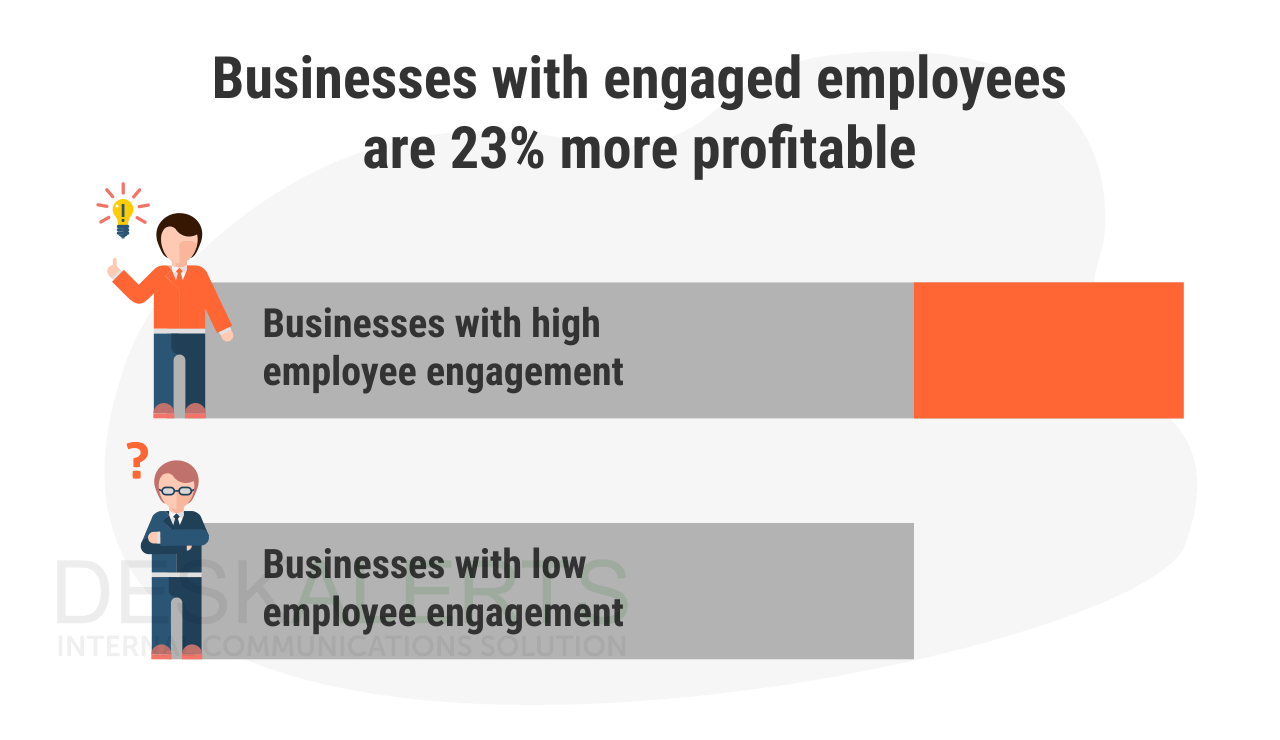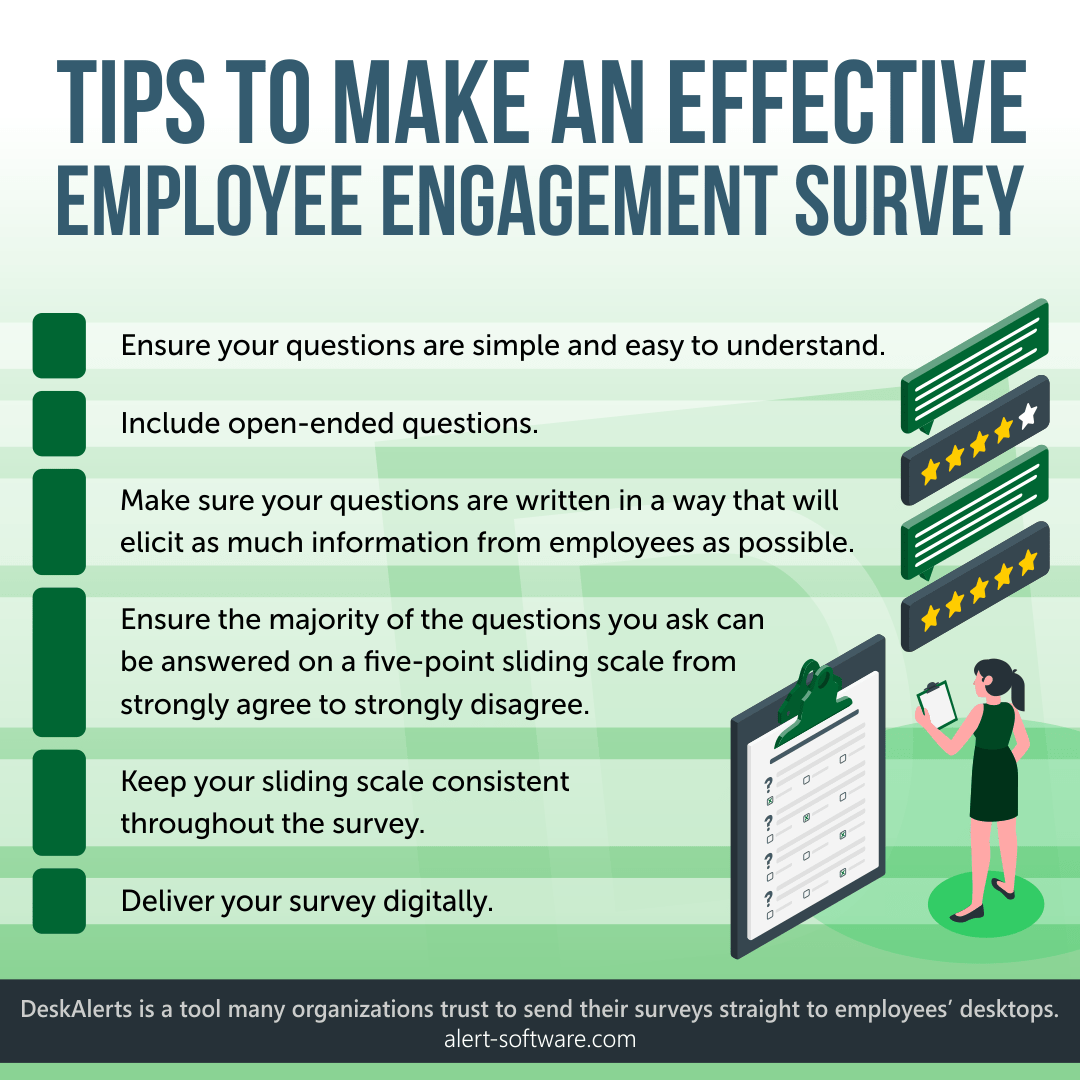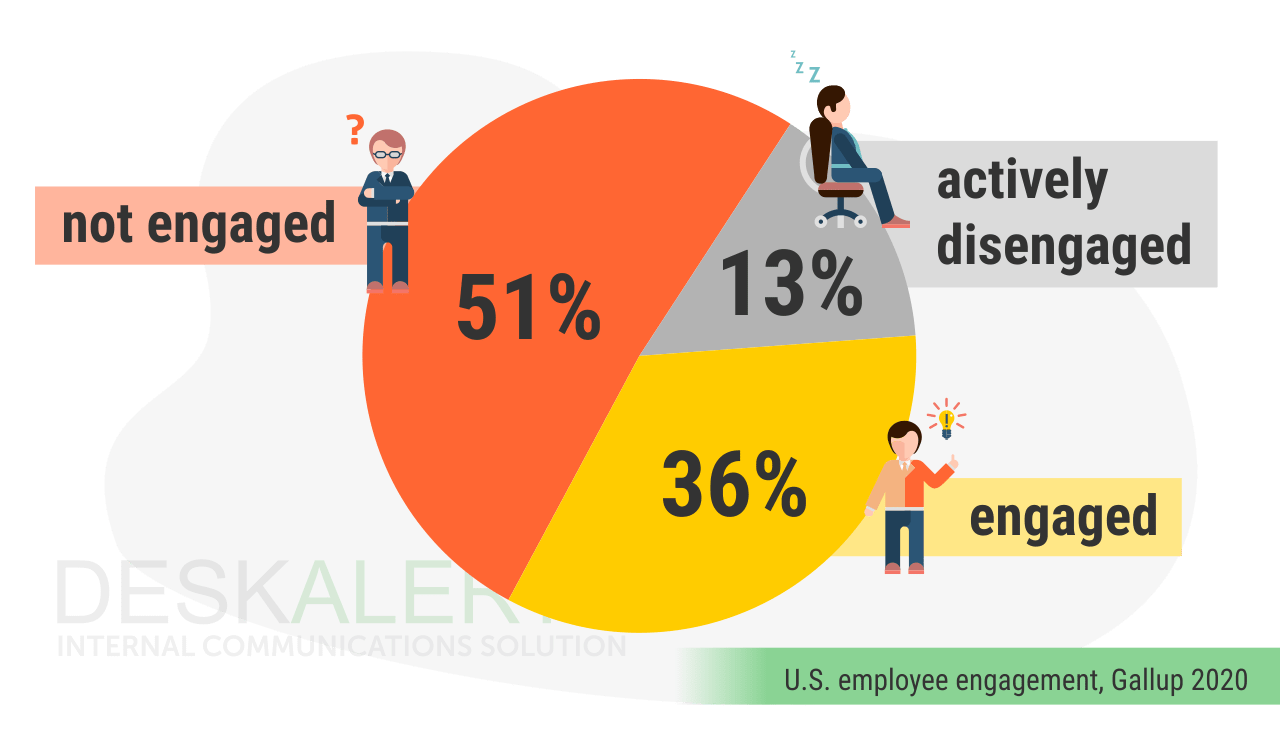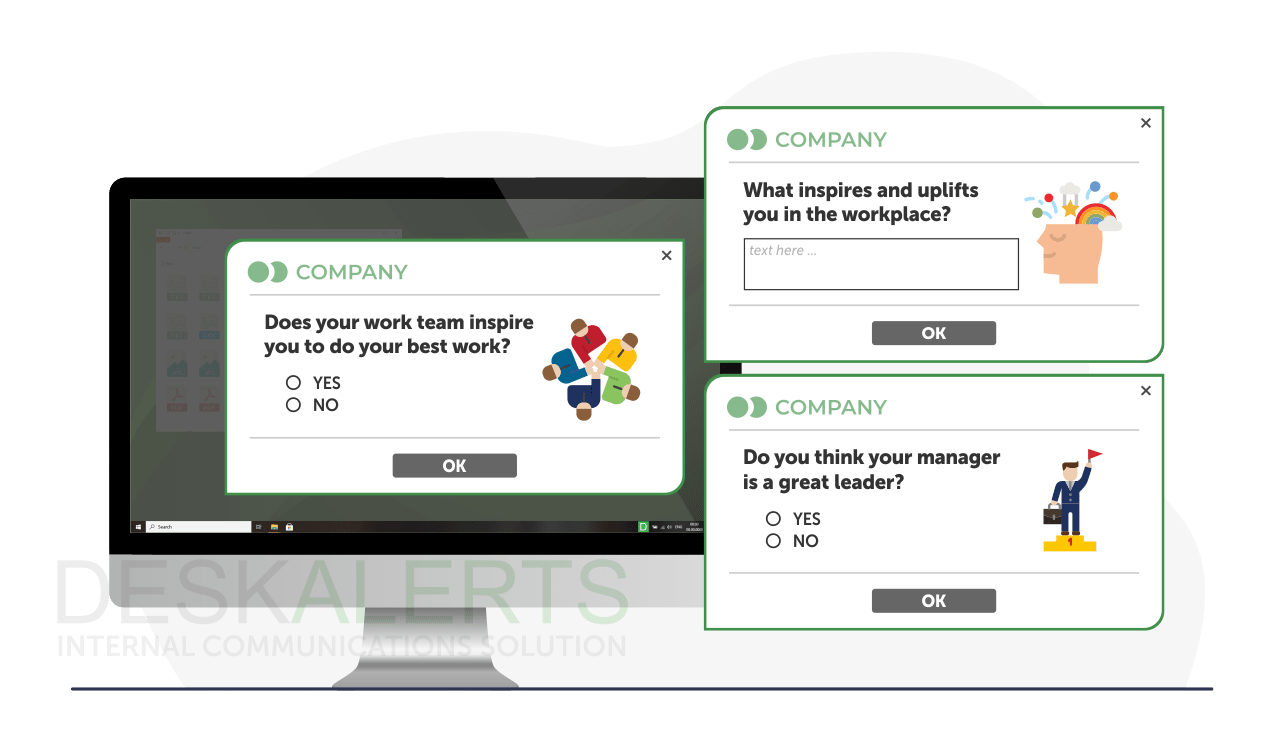
Employee engagement in the workplace is more important than ever before. With everything that is going on in the world, employees need to feel a solid connection with their workplace. Creating and delivering an employee engagement survey – sometimes called an employee satisfaction survey – is the first step toward understanding and improving the levels of employee engagement within your company.
Table of contents
Why use surveys to measure employee engagement?
The difference between employee engagement and employee satisfaction
Types of employee engagement surveys
5 steps to take to carry out a successful employee engagement survey
Top 80 employee engagement survey questions
Tips to make sure your staff engagement survey is effective
How to interpret your employee engagement results
Staff engagement statistics you need to know
How to use surveys to develop engagement strategies
Why you need DeskAlerts for employee engagement surveys
Why use surveys to measure employee engagement?
Employee engagement is the term used to describe how satisfied and connected your employees are with the organization. It goes beyond determining whether they are happy with their job, instead examining how committed and motivated they are to see the company succeed.
Engaged employees generally want to see the company reach its goals and will go above and beyond to help it get there. When employees are engaged they are more productive, motivated, deliver higher rates of customer satisfaction, help drive profits and deliver higher shareholder returns.
In order to determine how engaged your employees are, you need to use specialized employee engagement surveys that will provide you with the appropriate metrics. These surveys are designed to measure and assess the levels of motivation and engagement within your employee cohort.
The survey results will enable you to gain insights into the attitudes and thoughts about the workplace that your employees possess. They will also help you to determine any areas for improvement that will see your employees performing at their optimum.
The difference between employee engagement and employee satisfaction

The terms “employee engagement” and “employee satisfaction” are sometimes used interchangeably – but they shouldn’t be confused for the same thing. While they have some similarities, they also have their differences.
The term “employee engagement” describes the state of the workplace when employees are committed to seeing their companies succeed and meet their goals. They’re motivated to come to work every day and do whatever they can to ensure the company is successful.
“Employee satisfaction” on the other hand, describes the state of a worker enjoying his or her job. Employees can be satisfied without being engaged. They may be happy enough to do the work, but don’t necessarily care about the company’s overall success.
More on the topic: Employee satisfaction survey
Types of employee engagement surveys
Before you start conducting an employee survey in your organization, its important to understand the different types of surveys and how they can be used. Ultimately there are unique factors in every organization that will help determine the best fit. This includes the industry you operate in, the number of people in your team, the inter departmental makeup and geographic spread of employees.
1. Annual employee engagement surveys
Annual employee engagement surveys are usually carried out across an organization. This once yearly snapshot lets you gather high-level insights on how your employees are engaged across the board, covering topics such as turnover, employee experience, satisfaction with management, company culture and more.
The information will give you a benchmark to measure against year-on-year and you can also break the information down to compare engagement within different teams and other employee cohorts (eg: women, people working in a particular city).
2. Quarterly employee engagement surveys
A quarterly employee engagement survey provides more oversight about how employee engagement is tracking within an organization throughout the year. This is particularly useful in situations where there is a lot of change, or If you are actively trying to increase engagement: it gives you a better, more regular set of metrics that will show if there are any positive or negative changes.
3. Pulse surveys
Pulse surveys are short, regular questionnaires on employee engagement that are sent to staff on a weekly or fortnightly basis to measure engagement levels and provide management with real-time data about how people are feeling at work. These employee perception surveys will allow you to track if there are any trends or fluctuations in engagement levels over time, and can allow you to solve any problems before they escalate.
5 steps to take to carry out a successful employee engagement survey
When you’re ready to run an employee engagement survey, following these steps will help you achieve success:
1. MAKE SURE YOU’RE USING THE RIGHT EMPLOYEE SATISFACTION SURVEY TOOL
Using the right tool for the job will help to make your employee survey questionnaire more meaningful and the results easy to understand and interpret.
2. Get leadership buy-in
It’s important that the leaders in your company not only understand but support and endorse your employee experience survey efforts.
3. Properly communicate your survey
Letting people know about the survey in advance can help build excitement for it. It’s also important that you let employees know why you are asking for their feedback and opinions and what you will do with that information.
4. Benchmark survey results
You can look at credible benchmark data for your industry to get an idea about how well you are performing compared with other companies. This will give you insights about where you sit and how happy/unhappy your employees are. You also have a point to work from for future surveys.
5. Analyze the data and share the results
Once you’ve analyzed the data from the employee survey questionnaire, you will have some insights you can share. It’s important that you share the results with people – even if you are not happy with the results. If people are unhappy, you won’t be able to improve things if they perceive you are “hiding something” from them. Show people the results, both good and bad, and tell them what steps you will take to make improvements.
Top 80 employee engagement survey questions
If you aren’t sure about what to ask, try our sample employee engagement survey. The following engagement questions will help you to gain insights into different aspects of engagement across your workforce.
General morale questions for employee engagement:
1. Are you proud to work for [company name] ?
2. How do you feel about work today?
3. What could be done to increase employee involvement at [company name]?
4. Do you feel excited about coming to work every day?
5. Does [company name] motivate you to go above and beyond what is required of you?
6. Do you feel excited about the majority of your work and projects?
7. Do you find the work you do at [company name] to be meaningful?
8. Do you see a clear link between the company’s goals and your individual job?
9. What inspires and uplifts you in the workplace?
10. How satisfied are you with your current role within the organization?
11. Do you feel that your work contributes to the overall success of the organization?
12. Are you satisfied with the company’s physical work environment?
13. How well do you understand the company’s mission and values?
14. Do you feel that your skills and strengths are effectively utilized in the workplace?
15. Are you satisfied with the level of alignment between the company’s values and your personal values?
16. Do you feel the company provides opportunities for meaningful work and impact?
Training and development employee engagement questions:
17. Can you see yourself developing your skills and career with [company name]?
18. Do you think [company name] provides adequate opportunities for skill development?
19. Do you feel your manager has an interest in your career aspirations?
20. Are you satisfied with opportunities for career advancement within our organization?
21. Do you feel that your personal development is supported by the company?
22. Do you feel that your professional development is supported by the company?
23. How satisfied are you by the mentorship and coaching opportunities available to you?
24. Do you feel that the in-house training we deliver is of a professional standard?
25. Do you feel that the company provides opportunities for networking and professional connections?
26. How well do you think the company supports employees’ career development aspirations?
27. Do you feel that the company supports a culture of continuous learning?
Health and well-being employee satisfaction questions:
28. Do you believe [company name] has your best interests in mind when making company decisions?
29. Are you satisfied with our corporate wellness program?
30. Do you feel that your workload is reasonable?
31. How would you rate the work-life balance in your current role?
32. How would you rate the level of stress in your role?
33. Do you have concerns about your safety at work?
34. How would you rate the company’s efforts in fostering a healthy work environment?
35. Do you feel that the company values employee wellbeing?
36. Do you feel that the company encourages a healthy work-life balance?
37. Do you ever feel burned out?
38. Are you satisfied by the number of social activities and events held by the company?
39. How well do you feel the company supports employees affected by personal or family challenges?
Employee retention engagement questions:
40. How often do you think about looking for a job at another company?
41. How likely are you to recommend [company name] to family and friends as a great place to work?
42. Do you plan to be working at [company name] in the next two years?
43. Are you satisfied with your salary and benefits?
44. Do you feel that the company values diversity and inclusion?
45. Are you satisfied with the level of flexibility offered by the company?
46. Do you feel your compensation is competitive compared to similar roles in other companies?
47. How satisfied are you with the level of job security within the organization?
Management and work team engagement questions for employees:
48. Do you feel empowered to make decisions at work?
49. Does your work team inspire you to do your best work?
50. Do you think your manager is a great leader?
51. Do you have all the tools you need to do your job well?
52. Do you feel comfortable sharing ideas and opinions in the workplace?
53. Does your team work together to complete work?
54. Do you receive recognition for your work?
55. Do you feel comfortable raising a problem or asking your manager for help?
56. Do you feel that management at [company name] is transparent?
57. Do you feel your opinions and ideas are heard and valued?
58. How would you rate the level of teamwork within your department?
59. Do you believe all members of your team contribute equally or fairly to your team’s projects and goals?
60. How supported do you feel by your manager/supervisor?
61. Do you feel you can be creative and innovative in your role?
62. Are you satisfied with the level of autonomy you have in your role?
63. How would you rate the overall morale of your team or department?
64. Are you satisfied with the frequency and format of performance evaluations?
65. How satisfied are you with the level of cooperation between different teams in the organization?
66. How well do you feel management responds to employee feedback?
67. Are you satisfied by the level of support provided by the HR department?
68. How would you rate the level of trust between employees and management?
69. Do you feel that your performance is fairly evaluated?
70. How would you rate the level of engagement during team meetings?
71. How satisfied are you with the level of diversity in leadership positions?
72. Do you feel your manager or supervisor provides constructive feedback to help you improve?
73. How satisfied are you by the tools and technology that are provided to do your job?
74. How well do you think the company handles conflicts and disagreements among employees?
Communication questions for employee engagement:
75. Do you believe management communicates well with employees?
76. Has the [company name] leadership team communicated a vision that motivates you?
77. Are you satisfied with the level of communication in our company?
78. Do you think communication with staff is regular enough?
79. How would you rate the effectiveness of company-wide communications channels?
80. Do you think the organization communicates well with employees about major changes?
81. Do you feel like there is transparency in the way the company communicates with employees?
82. Are you satisfied by the level of communication between different departments or teams?
Tips to make sure your staff engagement survey is effective
Having the questions to ask your employees is just the start. In order to get the insights you need about engagement in your company, you need to consider the following best practice rules to ensure that your survey is effective:
- Ensure your questions are simple and easy to understand.
- Include some open-ended questions where employees are able to express their opinions, particularly on areas of improvement.
- Make sure your questions are written in a way that will elicit as much information from employees as possible.
- Ensure the majority of the questions you ask can be answered on a five-point sliding scale from strongly agree to strongly disagree.
- Keep your sliding scale consistent throughout the survey.
- Deliver your survey digitally so that it is easier for employees to complete and gives you results quickly, in real time. DeskAlerts is a tool many organizations trust to send their surveys straight to employees’ desktops.
How to interpret your employee engagement results

To make your employee engagement surveys count, you need to know how to interpret the information that they have given you. This means you need to know exactly what you’re looking at regarding employee engagement questions and answers.
As well as numbers that you can get from your sliding scale survey responses, the comments provided by employees provide valuable qualitative insights about why they have responded the way they have.
When you have your results you can present them in ways that will be useful for leaders in the organization, and HR, to work with to affect change. This includes:
- Creating engagement scores that provide management with an indication at a glance about how engaged employees are, overall as well as on a per-question basis.
- Understanding the response rate, both overall and to specific questions. You may find if there is a low response rate that people weren’t comfortable or willing to provide their honest feedback, which in itself is an indication of low engagement.
- Create heat map graphics which allow people to easily identify where there are problem areas with engagement in your organization, as well as showing where the strengths lie.
- Look at benchmarking different teams against the response of the organization as a whole.
Staff engagement statistics you need to know
If you’re still not convinced that you need to take action to understand and improve employee engagement in your organization, you may find these statistics sobering:
A Gallup report found that 51% of employees are not engaged in their workplaces, and only 36% are engaged.
The same Gallup report found that only 42% of employees feel that their manager keeps them informed about what is happening in their organization.
Another Gallup study found businesses with engaged employees are 23% more profitable.
A study from the Sloan Center for Aging and Work found that older employees tend to be more engaged in the workplace than younger ones.
A study from the Engagement Institute found that disengaged workers cost businesses between $450 and $550 billion annually.
How to use surveys to develop engagement strategies
Proactive employee engagement strategies are an essential guide to follow in order to improve engagement within the workplace. Your employee engagement survey data can be used to help develop these strategies. The data they produce give you a solid baseline that you can then benchmark against, which is better than just going by assumptions and impressions from the workplace.
Use the survey data to inform the strategy by analyzing the results, determining your strengths and weaknesses and look for opportunities for improvement.
You may find that some employee cohorts – eg: the accounting team – appear more engaged across the board while other teams – eg: the sales team – are disengaged. You may need to tailor your engagement strategy by different audience to bring about improvements where they are most needed.
Share the results with management and employees alike and get feedback around meaningful steps that you can take to improve engagement in your workplace context. You may even want to establish an employee engagement committee that has stewardship of the strategy.
Remember if you promise to do something, you need to follow through on it. Don’t produce an engagement strategy just for the sake of it: employees will undoubtedly determine that your efforts are insincere and this will in turn affect your engagement levels in a negative way.
Why you need DeskAlerts for employee engagement surveys

DeskAlerts is a trusted internal communications software system that features many different channels and tools to improve information sharing and boost employee engagement efforts. One of the key features of DeskAlerts is the ability to send surveys to employees in a way that bypasses emails and gets you results in real-time.
DeskAlerts surveys are delivered via on-screen pop-ups and sent to thousands of employees within seconds. They’re designed to be intrusive, and you can be guaranteed that everyone will see the survey – it won’t get lost or forgotten about in an invoice.
You can send entire employee or associate engagement surveys, or use it for pulse surveys. You can also send themed surveys, for example an employee climate survey questionnaire. Whichever you choose, you’ll be able to quickly and easily access the results so that you can get to work on making improvements to boost engagement.
***
Boosting employee engagement is important for any business that wants to succeed. Get in touch with us today to find out how our survey and other communication tools can help to make your employees more engaged.
Frequently asked questions
What is employee engagement?
Employee engagement is an approach taken in the workplace to ensure that workers are provided with the right conditions to see them give the company their absolute best each and every day.
What is the best employee experience tool?
The best employee experience survey tool to look for is one that has a good user interface, is easy for employees to use, integrates easily with your other applications and provides you with good value for money.
How to measure employee engagement?
There are several metrics that can be used to measure employee engagement. These include:
- Benchmarking your engagement goals and assess if these have been met.
- Sending employee engagement surveys
- Sending pulse surveys
- Examining your employee Net Promoter Score
- Determining your absentee rate
- Look at your staff turnover rates
- Look at the click-through rates of internal communications emails.
- Interview departing employees.
Why is employee engagement so important?
Employee engagement is important because it helps to improve your work environment and the workplace culture of your organization to encourage staff to be more dedicated to and invested in the company’s values and goals.
What should I ask in an employee engagement survey?
Employee engagement questions should be on the most common employee engagement metrics. This includes questions on employee engagement metrics such as morale, health and wellbeing, retention, communication, leadership, training and development, management and culture.
How do you run an employee engagement survey?
Employee engagement surveys can be run using software, such as DeskAlerts. Once you’ve designed your survey questions for employees, you simply input them into the software and deliver them to employees. Employees then respond to your questions on employee engagement, providing you with results and data.
What are the 5 questions to ask in a survey?
To gauge employee engagement effectively, consider these top five questions for your survey:
- How satisfied are you with your current role and responsibilities?
- Do you feel valued and appreciated for your contributions?
- Are you satisfied with the level of communication and feedback within the organization?
- Do you feel motivated and committed to the company's goals and mission?
- How likely are you to recommend our organization as a great place to work to others?
What is a good employee engagement survey?
A good survey on employee engagement effectively assesses various aspects of job satisfaction, organizational culture and employee well-being. It should include a mix of quantitative and qualitative questions that cover topics such as satisfaction with role and responsibilities, level of recognition and support, communication effectiveness, alignment with company values and overall willingness to recommend the organization.
Additionally, the survey questions for employees should be concise, easy to understand, and anonymous to encourage honest feedback, ultimately providing actionable insights to improve employee engagement and retention.
How many questions should be on an employee engagement survey?
An employee or associate engagement survey typically includes 20 to 30 questions to ensure thorough feedback while maintaining respondent engagement. It's essential to strike a balance between gathering comprehensive insights and respecting employees' time and attention.
 Caroline Duncan
Caroline Duncan












.jpg)